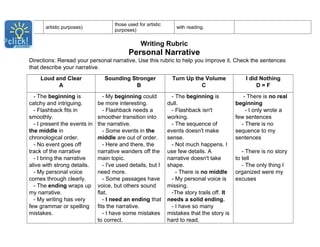The document provides rubrics for evaluating research papers, creative writing, and general writing assignments. The research paper rubric assesses content, organization, introduction/conclusion, and mechanics. Areas of evaluation include focus, support/elaboration, organization, and use of references. The creative writing rubric rates ability to engage the reader, originality, maintaining interest, clarity, and mechanics. A general writing rubric evaluates organization, development, sentence structure, word choice/grammar, and mechanics. Scores range from 1 to 6, with higher scores reflecting more proficient writing in the rated areas.









